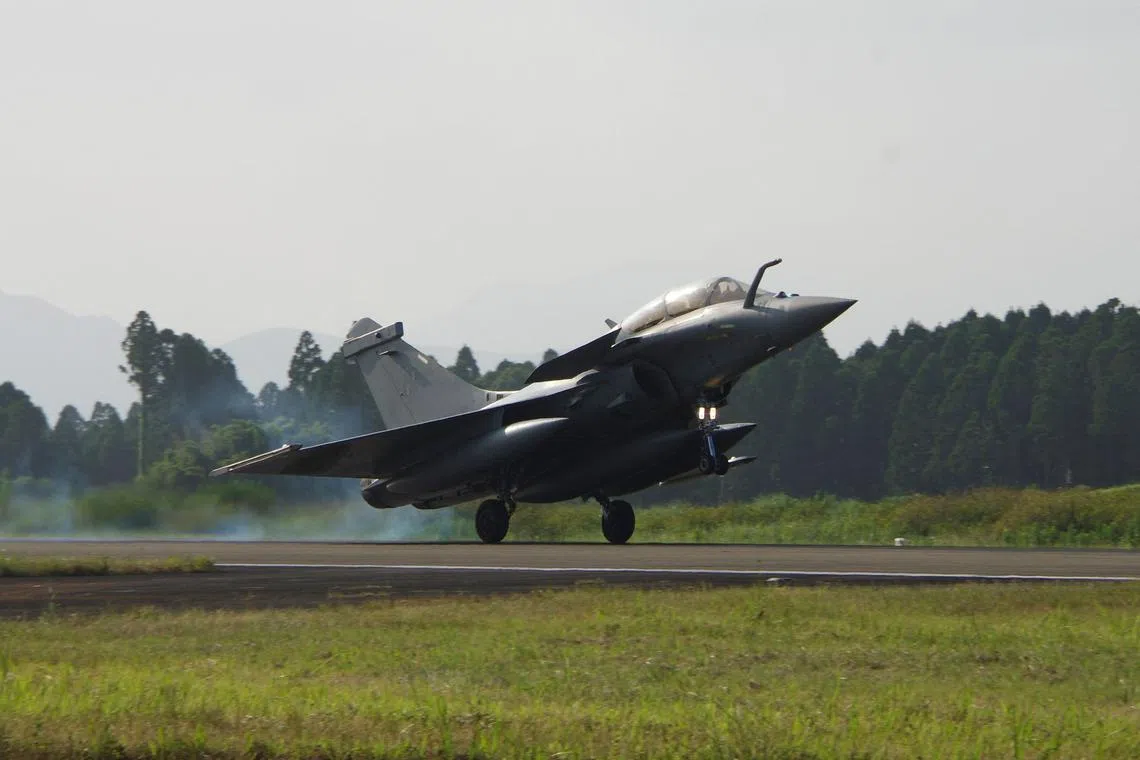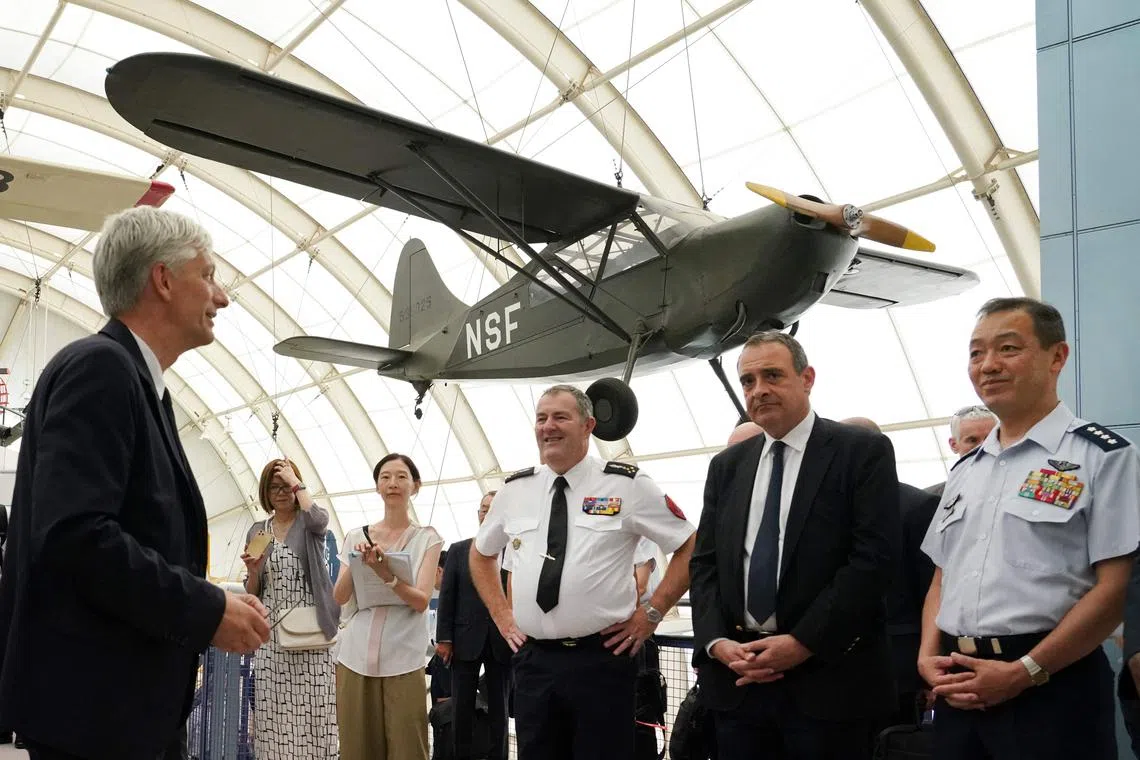‘Grim reality’ of regional crises behind Japan’s defence build-up: White Paper
Sign up now: Get insights on Asia's fast-moving developments

Japan will become the third-largest military spender in 2027, following a target to raise defence spending to 2 per cent of GDP.
PHOTO: AFP
Follow topic:
TOKYO – As French fighter jets swooped into Japan this week for their first-ever joint exercise, North Korean leader Kim Jong Un showed off to his Chinese and Russian guests nuclear-capable intercontinental ballistic missiles.
These events highlight what Japan’s Defence Ministry described on Friday as the “grim reality” of a “new era of crisis” in its 510-page White Paper, an annual defence review since 1976.
The document, singling out actions by China, North Korea and Russia as an affront to the international order, is a harbinger of Japan’s increasingly hawkish posture. On the cards are generous government subsidies to grow a domestic defence industry, and a relaxation of laws to allow the export of lethal weapons.
The military build-up and apparent unity by the three countries pose an existential threat for Japan, and Defence Minister Yasukazu Hamada said in the White Paper’s preamble that it must ramp up diplomacy and joint exercises with like-minded partners in response.
More importantly, he said, citing Japan’s sweeping defence policy overhaul
Japan has welcomed a decision – though deferred – by the North Atlantic Treaty Organisation to open a liaison office in Tokyo
Further, France is the latest in a growing list of countries to have dispatched fighter jets to Japan for joint drills since 2022, after Germany and India.
Italy’s combat aircraft will next swoop into Japan for their first joint exercise starting next Wednesday.
These engagements come as China, in particular, “presents an unprecedented and the greatest strategic challenge to which Japan should respond with its comprehensive national power and in cooperation” with like-minded countries, the White Paper said.
The language used to describe China echoes that in Japan’s new National Security Strategy in 2022, in which it signalled a sweeping overhaul of defence policy in recognition of regional crises.
The military balance between China and Taiwan is “rapidly tilting” in China’s favour, the White Paper said.
Pacifist Japan will become the third-largest military spender in the world in 2027 – up from 10th – following a headline-grabbing target to raise defence spending to 2 per cent of the gross domestic product (GDP) by then.
On its shopping list are stand-off defence capabilities, for which 5 trillion yen (S$47.7 billion) is being budgeted for the five years ending March 2028 – up from 200 billion yen in the preceding period.
Rather than accelerating an arms race, Japanese policymakers and experts are of the view that keeping the status quo – with an artificial cap on spending at 1 per cent of GDP – will make Japan a sitting duck.
Thus, Japan must strengthen its own military arsenal to ensure faster response to any attack, in case its partners are tied up in conflict elsewhere.
“Japan’s defence capabilities are the ultimate guarantor of national security and demonstrate Japan’s resolve and capability to defend itself,” the White Paper said, noting that Russia’s invasion of Ukraine was because “Ukraine did not possess sufficient capabilities to deter Russia’s aggression”.
Missile-armed Self-Defence Forces (SDF) units are being deployed across Okinawa prefecture, which will be at the front lines of any Taiwan contingency. Japan’s westernmost point – Yonaguni island – is just 110km from Taiwan.
Japan is planning to build underground bomb shelters on the picturesque tourist resort islands of Miyako, Ishigaki and Taketomi, alongside Yonaguni, local media reported this week.

(From right) Japan Air Self-Defence Force chief of staff, General Hiroaki Uchikura; France’s Ambassador to Japan Philippe Setton; and French Air and Space Force chief of staff, General Stephane Mille visiting the Tokorozawa Aviation Museum on July 28.
PHOTO: AFP
The White Paper added that another priority was to jump-start a moribund domestic defence industry, with the SDF’s current war-fighting materiel “not necessarily sufficient”.
More than 100 Japanese companies have quit the defence industry since 2003 over profitability concerns, hobbling Japan’s own manufacturing capabilities and raising doubts over its ability to respond in a crisis.
Defence has been a loss-making business given laws that prohibit the export of lethal weapons – making the SDF effectively the only client – and limits on defence spending.
This is set to change. In June, Japan passed laws to fundamentally rebuild and strengthen the defence industry, with massive subsidies for companies to enter the trade.
The Nikkei newspaper also reported on Tuesday that Japan is wooing 200 start-ups into the defence industry, hoping to take advantage of advanced technology such as surveillance drones and the metaverse to dupe enemies.
Japan now aims to relax laws against the export of weapons, noting that doing so would boost its security ties with other countries.
Unlike in 2022, when the White Paper had a colourful cover designed by artificial intelligence, 2023’s edition has a black-and-white cover featuring calligraphy written by an SDF member.
“With supple and powerful brushstrokes, the cover symbolises our resolve to build a robust defence architecture to protect our people,” said the Defence Ministry.
Peace and security, after all, “cannot be secured simply by wishing for them”.


